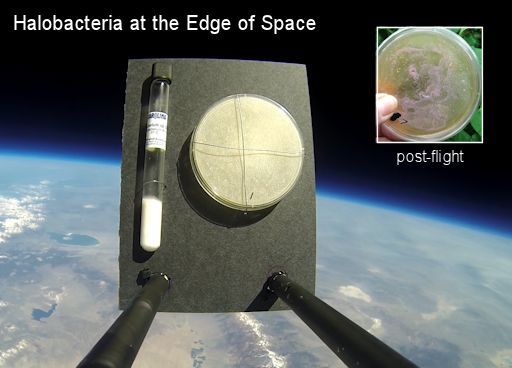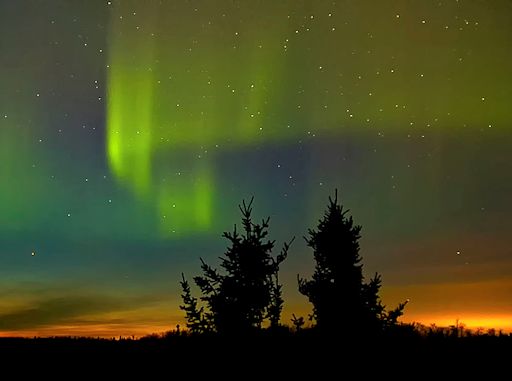Listen to radar echoes from satellites and meteors, live on listener-supported Space Weather Radio. | | |
CHANCE OF FLARES: Growing sunspot AR2049 has a 'beta-gamma' magnetic field that harbors energy for M-class solar flares. This active region is turning toward Earth so geoeffective flares are possible in the days ahead. NOAA forecasters estimate a 20% chance of M-flares on May 1st. Solar flare alerts: text, voice
BACTERIA SURVIVE TRIP TO THE EDGE OF SPACE: Researchers pondering the possibilities of life on Mars have long focused their attention on halobacteria--a type of terrestrial extremophile that uses salt to shield itself from harsh radiation. On April 20th, the students of Earth to Sky Calculus flew a colony of halobacteria onboard a suborbital helium balloon to the Edge of Space. The microbes didn't merely survive, they are now thriving in the students' biology classroom back on Earth:

During the ascent to 102,400 feet, these bacteria experienced temperatures as low as -60 C, air pressures only 1% that at sea-level, and radiation levels more than 25-times Earth-normal. All of these conditions are akin to those on Mars. ( See a 74 MB movie of the bacteria floating in the stratosphere.)
Instead of chlorophyll, halobacteria use the photosynthetic molecule bacteriorhodopsin, which produces chemical energy from sunlight without producing oxygen. This photosynthetic pigment colors the halobacteria colony pinkish-red--the same hue visible in the incubated petri dish.
The students are planning to repeat the experiment with another flight possibly as early as this weekend. If you would like to support their efforts, please consider purchasing an Edge of Space Mother's Day card (described below). Profits buy helium and other supplies for this research.
MOTHER'S DAY AT THE EDGE OF SPACE: Mother's Day is right around the corner. Looking for a unique gift? How about an Edge of Space Mother's Day Card? The students of Earth to Sky Calculus are about launch another helium balloon to the stratosphere. For only $49.95, your Mother's Day, Father's Day, birthday or anniversary card could be on the payload. Profits from the flight are used to support the students' space weather balloon research program. Contact Dr. Tony Phillips for details.
Realtime Space Weather Photo Gallery
SUNSET AURORAS: Last night, April 30th, the interplanetary magnetic field (IMF) near Earth tipped south, opening a crack in our planet's magnetosphere. Solar wind poured in and ignited a display of auroras bright enough to pierce the Spring twilight around the Arctic Circle. Nancy Dean sends this picture from Sterling, Alaska:

"Bright and beautiful auroras danced all night across our Alaskan sky," says Dean. "The colors of sunset made the display even better."
Meanwhile in the southern hemisphere, autumn is unfolding, and the night sky is growing darker. The display was even more dramatic there. Photographer Brendan Davey says "the glow from Tasmania was very bright."
The crack in Earth's magnetosphere has mostly closed, but the IMF could open it again. NOAA forecasters estimate a 50% chance of polar geomagnetic storms on May 1st. Aurora alerts: text, voice
Realtime Aurora Photo Gallery
Realtime Mars Photo Gallery
Realtime Comet Photo Gallery
Every night, a network of NASA all-sky cameras scans the skies above the United States for meteoritic fireballs. Automated software maintained by NASA's Meteoroid Environment Office calculates their orbits, velocity, penetration depth in Earth's atmosphere and many other characteristics. Daily results are presented here on Spaceweather.com.
On May. 1, 2014, the network reported 2 fireballs.
(1 eta Aquariid, 1 sporadic)

In this diagram of the inner solar system, all of the fireball orbits intersect at a single point--Earth. The orbits are color-coded by velocity, from slow (red) to fast (blue). [Larger image] [movies]
Potentially Hazardous Asteroids (
PHAs) are space rocks larger than approximately 100m that can come closer to Earth than 0.05 AU. None of the known PHAs is on a collision course with our planet, although astronomers are finding
new ones all the time.
On May 1, 2014 there were 1470 potentially hazardous asteroids.
Notes: LD means "Lunar Distance." 1 LD = 384,401 km, the distance between Earth and the Moon. 1 LD also equals 0.00256 AU. MAG is the visual magnitude of the asteroid on the date of closest approach. | | The official U.S. government space weather bureau |
| | The first place to look for information about sundogs, pillars, rainbows and related phenomena. |
| | Researchers call it a "Hubble for the sun." SDO is the most advanced solar observatory ever. |
| | 3D views of the sun from NASA's Solar and Terrestrial Relations Observatory |
| | Realtime and archival images of the Sun from SOHO. |
| | from the NOAA Space Environment Center |
| | the underlying science of space weather |

